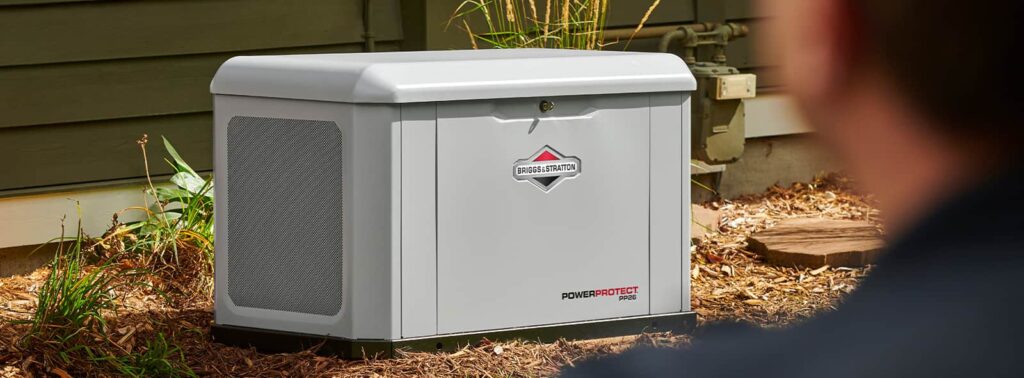Don’t Let the Snow Stop the Power: Operating Your Generator in Cold Weather

August 9, 2023
When winter weather hits and the snow starts falling, power outages often follow. Winter storms with heavy snow, ice and freezing rain can weigh down power lines and electrical infrastructure. Trees limbs also fall in the weight of snow and ice, snapping cables and poles in the process.
While you may rely on a home backup generator to provide emergency electricity, extreme winter conditions raise valid concerns over generator performance and reliability. Will your generator still operate properly and provide power if it’s engulfed in feet of snow or encrusted in ice? Here’s what you need to know about generator operation and care in cold, snowy weather.
How Temperature Impacts Fuel and Engine Performance
For portable gasoline generators, very cold temperatures affect both engine performance and the gasoline itself. Gas that sits unused for months loses volatility, making it harder to ignite in the engine. The thicker, sludge-like consistency hampers fuel lines and carburetor function. Stored gasoline also absorbs moisture from the air which can freeze and obstruct flow.
Even with treated gas, engine oil also thickens in sub-freezing temperatures. The increased viscosity makes it harder for the starter motor to crank and ignition to occur. Extreme cold saps battery strength as well, reducing cranking power further.
With diesel-powered portable generators, the diesel fuel can gel in frigid weather, clogging filters and fuel lines. The engine’s glow plugs, block heater, and battery may also struggle to start the motor in arctic temperatures.
For permanently installed standby generators fueled by natural gas or propane, the risk of fuel issues is lower. But the engine oil and components still face cold weather starting challenges. Systems that sit idle all summer should be inspected and serviced before winter.
Protecting Your Generator from Snow and Ice
A generator enclosed or sheltered from heavy, wet snow will have far fewer problems than one buried and encrusted. Where you locate the unit on your property matters. Try to find a spot that avoids exposure to blowing and drifting snow. Near the home, under eaves is ideal.
For portable generators on the ground, placing a cover or tarp over the unit when not in use prevents snow and debris buildup inside the generator. Don’t enclose it fully or run the engine with the cover on. Ensure openings allow air exchange to prevent carbon monoxide poisoning. Remove snow and ice accumulations promptly after a storm.
Install permanent standby generators on an elevated concrete pad to avoid snow burial and flood risks. Keep the generator exterior and vents clear of snow and icicles for safe operation. Inspect fuel lines and conduits after storms to confirm no snow or critters have obstructed the system.
Preparing Your Generator for Winter
Aside from external protection and location out of deep drifts, take a few key steps to ready your generator for cold weather:
– Service the engine, replace oil, plugs, filters, battery. Ensure it’s in top condition.
– Add fuel stabilizer and treat gasoline to prevent gelling and moisture issues. Maintain proper propane or natural gas supply.
– Confirm remote and automatic starting functions if installed.
– Inspect insulation on wiring and conduits to prevent freezing moisture damage.
– Install a battery warmer pad if very cold temps are common.
– Check antifreeze strength and top off if needed.
– Ensure adequate engine block heater for diesel generators.
– Test and confirm proper operation in cold before winter hits. Fix any issues immediately.
– Verify enclosure heater functions if installed to melt snow and ice.
– Register generator for any firmware updates from the manufacturer if connected model.
Operating Your Generator Safely in Winter
When you must run your generator in snowy conditions, follow these precautions:
– Clear snow and ice away fully before turning it on.
– Shelter unit from blowing snow during operation if possible. Close vents if needed.
– Wipe off accumulated moisture inside the enclosure to prevent freezing.
– Inspect fuel, exhaust and wiring conduits to ensure no blockages.
– Give extra cranking time for cold starts – don’t flood it.
– Monitor for any frozen moisture or ice developing on components that could cause damage.
– Ensure exhaust is venting away from home to prevent CO poisoning.
– Check and refuel more frequently as fuel is consumed faster to produce heat.
– Monitor voltage and load levels to prevent overworking in cold weather.
With proper preparation, inspection, care and operation, home generators can provide reliable backup electricity even in the worst winter conditions. Maintain your system well and don’t let snow or cold weather catch you off guard. Follow the manufacturer’s winter guidelines. And test run periodically to be confident of smooth performance when you need it most.


